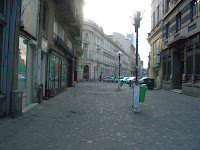Diada de Sant Jordi
Yesterday, April 23, was St. George’s Day, the Diada de Sant Jordi, the Catalan equivalent of Valentine’s Day. The day marked an anniversary: I arrived in Barcelona on St. George’s Day last year, ready to begin my Barcelona adventure. It’s been exactly one year, more or less, since Barcelona has been home. The Catalan tradition for Sant Jordi is for men to buy women a rose bundled with a palm or stalk of wheat, and for women to buy men a book. This year, Andrew bought me a beautiful bouquet of red roses, orchids, palms, and small purple flowers; I bought Andrew Orhan Pamuk’s Snow . The whole city filled with books and flowers. On La Rambla, roses and wheat stalks wrapped in cellophane and tied with ribbon in the colors of the Catalan flag filled plastic buckets, and stacks of books—mostly in Catalan—spilled over on tables. Andrew learned during his internship last summer that 30% of Catalonia’s book sales occur on the Diada de Sant Jordi. We strolled through the city yesterday and were...





